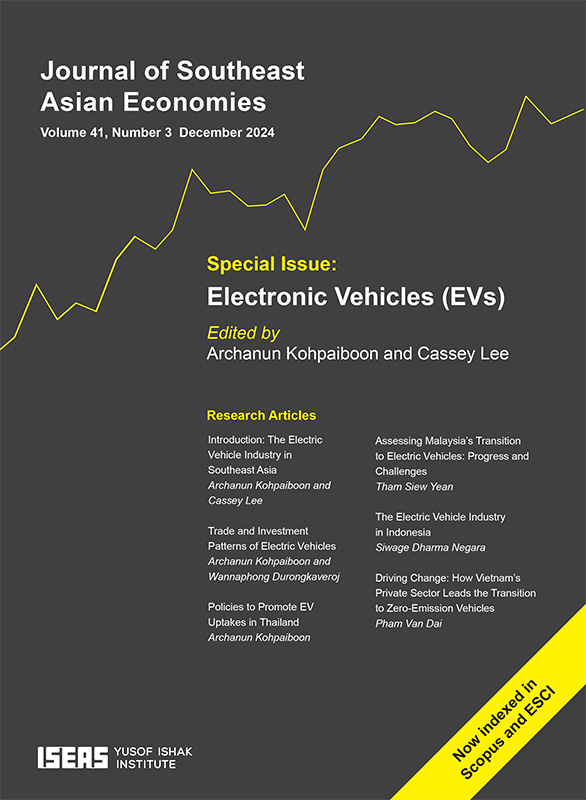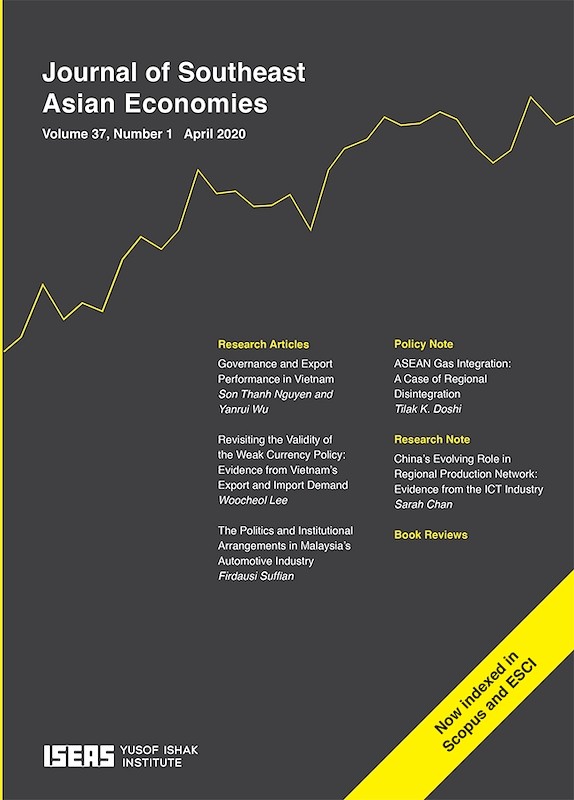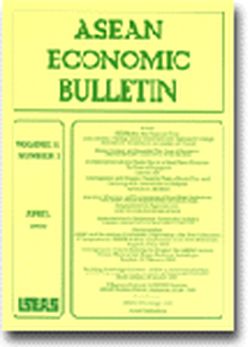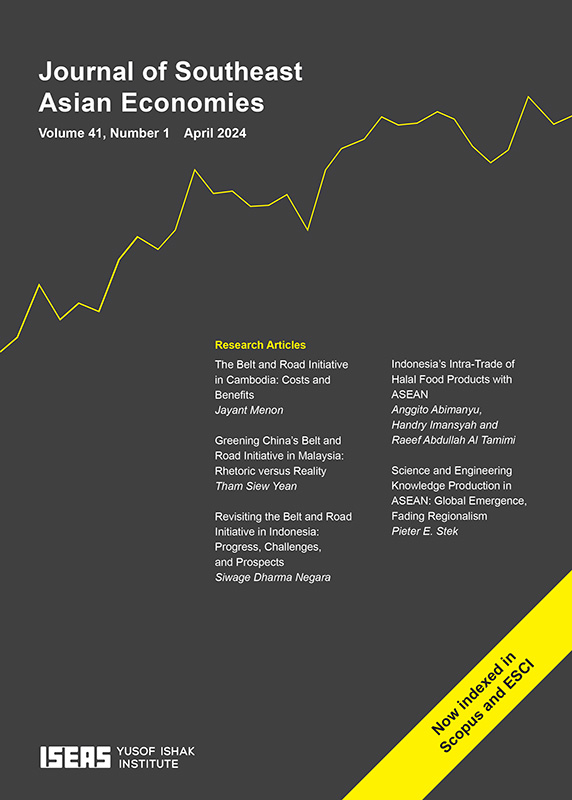Journal of Southeast Asian Economies Vol. 38/2 (August 2021). Special Focus on "Southeast Asia’s Automotive Sector at Crossroads: Current Changes and Future Challenges"

Tham Siew Yean, editor
Date of publication:
August 2021
Publisher:
ISEAS – Yusof Ishak Institute
Number of pages:
128
Code:
AE38/2
Contents
-
Journal of Southeast Asian Economies Vol. 38/2 (August 2021). Special Focus on "Southeast Asia’s Automotive Sector at Crossroads: Current Changes and Future Challenges"
[Whole Publication, ISSN: 23395206] -
Preliminary pages
- RESEARCH ARTICLES
-
1. Southeast Asia’s Automotive Sector at Crossroads: Current Changes and Future Challenges—Introduction, by Tham Siew Yean, author
-
2. Indonesia’s Automotive Industry: Recent Trends and Challenges, by Siwage Dharma Negara, Agus Syarip Hidayat, authors see abstractIndonesia’s growing middle class is the key driver of the rapid growth of the country’s automotive industry over the last decade. Stable economic growth and government policies are other contributory factors, especially during the commodity boom period (2006–15). While there is some indication of improvements in the competitiveness of the industry, several structural weaknesses continue to hamper its growth. Traditionally, the industry has been dominated by Japanese car manufacturers, but Korean and Chinese carmakers have recently entered the sector. Although Japanese players have a strong comparative advantage in producing Internal Combustion Engine (ICE) cars, the newcomers are targeting a fresh segment—Electric Vehicles (EVs). The latter has been identified as one of the new priority industries based on global trends. This paper examines the recent developments and challenges in Indonesia’s automotive industry. It examines key policies and their implications for the future of the sector.
-
3. Global Trends and Malaysia’s Automotive Sector: Ambitions versus Reality, by Tham Siew Yean, author see abstractThis paper examines the development of the Malaysian automotive sector in the midst of rapid global changes in technology, consumer preferences and sustainability concerns. The sector represents a case of infant industry “protection-plus” as it includes among its objectives, the state’s aspiration to nurture bumiputra entrepreneurs as national champions for this sector. Despite close to three decades of protection, the two national cars continue to depend on foreign partners for technology support. The National Automotive Policies (NAPs) strive to push the sector towards the technology frontier with foreign and domestic investments while seeking to be a regional hub and groom national Bumiputra champions, including an impending third national car. The inherent conflicts in these objectives create disincentives for investments while the domestic market is held captive to the national car producers. Although policies continue to espouse grand visions, the reality is that Malaysia’s carmakers continue to be inward looking while exports remain insignificant.
-
4. Technological Upgrading and Challenges in the Thai Automotive Industry, by Patarapong Intarakumnerd, author see abstractOver the last sixty years, Thailand has become the “Automotive Hub of Asia”, shifting from import substitution to export orientation, including an increasingly significant role in the automobile global value chain (GVC). Key contributory factors towards this shift include: (i) government incentives targeted at technologically sophisticated activities; (ii) collaborations among universities, research institutes and industry in sector-specific teaching and research programmes; and (iii) a shift in a sector-specific government promotion agency towards “intermediary” activities that facilitate collaborations among stakeholders. Local firms, through indigenous strategies and efforts, have fostered position upgrading in the GVC. The industry has upgraded from a production base to a more innovation and R&D-intensive one, while becoming more product-specific. Outstanding challenges lie in the adoption of new technologies. While robotization in production has been implemented extensively, the push for production of electric vehicles (EVs) has yet to succeed.
-
5. Stuck in Neutral: Vietnam’s Automobile Industry Policy, by Martin Schröder, author see abstractVietnam’s automobile industry is undergoing transformational change as the country is pursuing global and regional economic integration. While this overall policy direction is unambiguous, sectoral policy suffers from contradicting policy objectives of different ministries, lacking coordination and clarity in government-industry communication. Analysis of policy measures indicates that Vietnam briefly sought to protect the automobile industry from liberalization, but quickly abandoned these measures as they proved to be ineffective. To allow Vietnam’s automobile industry to develop further, it is suggested that the government must overcome internal conflicts, improve stakeholder participation and extend support to the supplier industry, which provides most inputs for vehicle production.
- ORIGINAL RESEARCH ARTICLE
-
6. Political-Economic Suboptimization of China’s Belt and Road Initiative: The Case of Infrastructure Investments in Southeast Asia, by Jan P Voon, Chung Chien-peng, Chan Sze Nam, authors see abstractThis paper shows that ASEAN benefits significantly from investments in transport infrastructure such as road, railway and port, but not as much from investments in non-transport infrastructure such as real estate. However, using data collected from several sources, including secondary data on the number of infrastructure projects already invested and earmarked to be invested as well as China’s direct foreign investment to Southeast Asia, this analysis shows that non-transport infrastructure constitutes a substantially higher proportion of the total infrastructure investments in Southeast Asia than transport infrastructure since the launch of the Belt and Road Initiative (BRI). This points to a suboptimization polemic emanating from the mismatch between the inflows of the different types of infrastructure investments and ASEAN’s need for these inputs for sustainable economic growth. Domestic disharmony, regional rivalry and political conflicts between China and ASEAN as well as other obstacles such as the debt-trap worries reduce the total investment flows to Southeast Asia, exacerbating the suboptimization problem.
- ORIGINAL RESEARCH NOTE
-
7. Indonesia’s Ultra Microcredit Programme: Financing Micro Businesses and Empowering the Poor, by Latif Adam, M. Soekarni, Ika Inayah, authors see abstractThis paper examines the Indonesian government’s new microcredit programme, the Ultra Microcredit (UMi) scheme, designed to provide cheap, hassle-free loans to micro businesses (MBs) owned by the poor and vulnerable. Based on UMi’s loan disbursement, the number of participating non-bank financial institutions (NBFIs), the number of borrowers and its impact on the borrowers’ business performance, this paper shows that the programme has so far been significantly promising in supporting the development of MBs. This study not only highlights the ways in which UMi has addressed various problems that MBs face, but also details the scheme’s limitations in achieving its large-scale anti-poverty objectives. The results show that UMi’s main policy challenges can be overcome by: first, shifting its distribution away from Jakarta and towards the less prosperous provinces of the country; second, improving business facilitation services; and third, complementing the scheme with other non-financial programmes.
- BOOK REVIEWS
-
BOOK REVIEW: The Political Economy of Southeast Asia: Politics and Uneven Development under Hyperglobalisation, 4th ed., edited by Toby Carroll, Shahar Hameiri and Lee Jones, by Francis E Hutchinson, author
-
BOOK REVIEW: Striving for Inclusive Development: From Pangkor to a Modern Malaysian State, by Sultan Nazrin Shah, by Lee Hwok Aun, author
-
BOOK REVIEW: The Political Economy of Growth in Vietnam: Between States and Markets, by Guanie Lim, by Tran Van Tho, author
-
In Memory of Professor Josef Silverstein (1922–2021)






